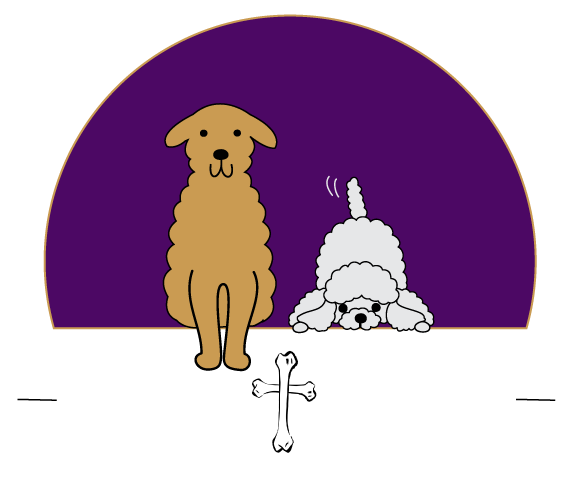Minerals to improve breeding ability – Last night I was talking with a long time breeder who had 2 females she bought for breeding that, although they were having heat cycles, had never managed to get pregnant. She also had a couple of males who, not for lack of trying, had never gotten a female pregnant. We did some testing on her dogs, and found a deep, long-standing mineral deficiency. To remedy this situation, her husband went out and bought a 4# mineral block, typically used for livestock, and put it in a bucket, then poured water over it. After the water set for a few minutes in the bucket, he intended to pour it into the dogs’ water dishes. What happened though, was a complete surprise. He said he had never seen his dogs go after water like they did that water, and it was still in the bucket. One male dog drank half the bucket before he could even pour it in his dish. The others, and there are several, were just as excited to drink the water. We will see if this changes how they breed. I am fully expecting them to have normal, productive heat cycles, as well as bigger, healthier litters. (posted August 2016)
Follow-up (as of Jan 2017)
A couple weeks ago I talked again with the breeder who’s dogs couldn’t conceive. I wanted to see if the minerals had helped any of them to be able to get pregnant. I initially thought there were only 2 females who couldn’t conceive, but learned there were really eight. All eight now currently have puppies. Wow, how are you taking care of that many litters at the same time I asked. She laughed, and said they were making due, but never expected this to happen. The 8 litters all came within 9 weeks of each other. It was a surprise to have so many pregnant at the same time, and such a simple fix – just the addition of minerals. Its common to have this happen (simple fix) when there are no chemicals or vaccines in the way. It makes such a difference.
Diet is everything – A few months ago I got a call from a breeder who inquired about using my male standard poodle as a stud for her female. She wanted to use him because she was familiar with his pedigree from her 40 years of breeding and showing poodles with the AKC. Her female is an older dog, and she thought maybe she could get 1-3 puppies out of her, and this would be her last breeding. I asked her what she feeds her dog and suggested she increase her minerals and meat before trying to breed her. She was just getting kibble at the time, and really couldn’t afford anything else. When it was time, the dog came to my house and stayed with our stud a week to be bred. During that week, I fed her raw eggs, raw meat, bones, and healthy well water so she would get lots of minerals. Eight weeks later she whelped (gave birth) to 6 puppies. Once again I asked the breeder about her dogs diet, and learned it was still just kibble.
Diet/nutrients mean everything to the health of animals as well as humans. If you want healthy puppies, healthy breastmilk for those puppies, and for them to be disease free, the best thing you can do is feed them a nutrient rich diet, free of chemicals, preservatives, and other toxins. A week later I learned 2 of the puppies had died. It breaks my heart. This woman, well-meaning as she is, is the same mindset as many of the breeders I speak with, they are so used to losing puppies, even up to most of the litter that they think its normal. I will know in a few more weeks if any of them survive.
We have all heard the saying “In nature, the strong survive and the weak die”. I know this is true, and it’s because of the lack of appropriate food, water and shelter that this happens. We, however, have the opportunity to change this when the animal is in our care. All we have to do is make sure the mother is well-fed and cared for, and therefore all of the puppies have a good chance to be “strong.” (posted August 2016)
Follow-up (as of Jan 2017)
I feel like I was hasty when I said earlier that “diet and nutrients mean everything to the health of animals…” I know its true, but I should have kept my focus more on God’s plan in all of this. I haven’t been breeding my dogs for very long, so I’m still a bit of an idealist. I want to save all of the puppies that are born to my dogs. But, watching the puppies grow, day after day (I do keep a close watch), I had missed the mother’s side of things. After this last litter, which was a big one, eleven puppies, all whom survived, I have shifted my attention more to the mother’s health and well-being regarding the care of the puppies. The mother/dam of these eleven puppies was on a good diet of raw meat and eggs throughout the pregnancy and after their birth. She did exceptionally well during the birth, having no problems whatsoever, even cleaned the puppies as they were coming out, and ate all of the placentas just as they were being delivered. Amazing! There was little to no mess at all from the birth.
She then diligently cleaned and cared for each of her puppies, and even went so far as to wrap herself around them to prevent anyone from seeing or touching them. I should add that, there were only two of us present, both of whom she trusts and adores. But, when it came to her puppies, we weren’t even good enough to touch them. I take that to be a sign of a good mother.
Fast forward a week and we noticed that some of the puppies were getting weak because they were unable to get to the nipples enough due to the bigger, more aggressive puppies, getting their first. Even when they were able to latch onto a nipple, one of the bigger puppies would knock them off and take it over. And, this was before their eyes were open! For the less aggressive puppies to survive, it required help from a person to purposely remove the bigger puppies from the nipples after a few minutes of nursing and put the smaller ones on. There was nothing the mother could do without help from a human. With help, all of the puppies gained the needed weight and were thriving. Without help, at least these 4 would have died.
Week two- When the eyes of the puppies opened, and the mother went into the “nest” to nurse them, the more aggressive puppies were even more diligent about getting to the nipples first. Taking them off the nipples after a few minutes wasn’t enough to allow the smaller, less aggressive puppies adequate time to nurse. They had to be moved further away from their mother, where it would take them longer to crawl back. This had to be done with each nursing in order to give the littler ones enough time to nurse before they were once again knocked off the nipple.
Week three – All puppies were thriving well, but only with a lot of intervention to make sure each got an adequate amount of milk. By the end of the third week the puppies were able to have their diet of mother’s milk supplemented with goat’s milk. They not only loved it, but thrived on it. They would always be nursed first, to make sure they got as much of their mother’s milk as they could, then followed-up with a dish of goat’s milk.
Week four – The puppies were getting big enough that their size alone would allow only 4 puppies to nurse at a time. Without human intervention, I think we would have been down to just 4, maybe 5 puppies who survived. That means 6-7 would have died. This observation helped me to realize what “survival of the fittest really means” regarding dogs. Although I am grateful we were there to help, intervene, and supplement as needed, it was a good lesson for me in animal husbandry. I had simplified the birth process to being about diet and the mother’s willingness to nurse their young. But there is so much more to it then that, including the natural law of survival of the fittest.








